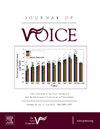砂砾量表评分预测语音治疗依从性和结果的有效性
IF 2.4
4区 医学
Q1 AUDIOLOGY & SPEECH-LANGUAGE PATHOLOGY
引用次数: 0
摘要
语音治疗通常被认为是语音障碍和声带麻痹的一线治疗方法。它需要投入时间、精力和资源;目前,还没有很好的指标来确定哪些患者是语音治疗的好候选人。毅力量表是由心理学家安吉拉·达克沃斯开发的,它提供了一种量化毅力和对长期目标的承诺的方法。目的:我们假设Grit量表得分与患者对语音治疗的依从性和结果相关,即Grit量表得分高的受试者表现出更强的依从性和更好的结果。方法将研究对象分为五组:(1)成功完成治疗后出院;(2)改善到正常、接近正常或患者满意的语音功能水平,然后停止参加治疗;(3)至少参加建议次数或超过8次,有一定的语音改善;(4)尽管参加了语音治疗,但未能改善到患者满意的语音功能水平。(5)未按建议参加语音治疗。1-4组的受试者被认为坚持语音治疗,而第5组被认为不坚持。第一类被认为是最有利的结果,而第5类被认为是最不利的结果(1 > 2 > 3 > 4 > 5)。结果共纳入89名受试者。研究对象的平均年龄为44.9岁,男女比例几乎相等。粘附组(1-4类)的平均Grit评分(48分)与非粘附组(47分,P = 0.190)差异无统计学意义。Grit量表得分与分类(1 > 2 > 3 > 4 > 5)的Spearman’s rho为0.0674,P = 0.530。结论分组分析和所有类别的Spearman相关性都不支持我们的假设,即更高的Grit量表得分与更好的依从性和结果相关。砂砾量表评分在预测语音治疗依从性和结果方面的失败强调了进一步研究的必要性,以找到一个有助于预测和提高患者对语音治疗和语音结果依从性的指标。需要进一步的研究来确定为什么它不能预测,并证实或反驳我们的发现。本文章由计算机程序翻译,如有差异,请以英文原文为准。
Efficacy of the Grit Scale Score in Predicting Voice Therapy Adherence and Outcomes
Background
Voice therapy generally is considered first-line treatment for dysphonia and vocal fold paresis. It requires a commitment of time, effort and resources; currently, there is no good indicator to identify which patients are good candidates for voice therapy. The Grit scale, developed by psychologist Angela Duckworth, provides a method to quantify perseverance and commitment to long-term goals.
Objective
We hypothesized that the Grit scale score could correlate with patient adherence to voice therapy and outcomes, by which subjects with higher Grit scale scores demonstrate greater adherence and better outcomes.
Methods
Subjects were categorized into five groups, subjects who (1) were discharged from therapy after successful completion, (2) improved to normal, near-normal, or a level of voice function with which the patients were satisfied, and then stopped attending therapy (3) attended as at least the recommended number of sessions or greater than 8 sessions with some voice improvement (4) failed to improve to a voice function level satisfactory to the patient despite attending voice therapy, (5) failed to attend voice therapy as recommended. Subjects in groups 1–4 were considered adherent to voice therapy, whereas group 5 was considered not adherent. Category 1 was considered the most favorable outcome, whereas Category 5 was considered the least favorable outcome (1 > 2 > 3 > 4 > 5).
Results
Eighty-nine subjects are included in the study. The average age of subjects was 44.9 years old, and there was a nearly equal split between male and female subjects. The mean Grit score (48) of the adherent group (categories 1–4) was not significantly different from that of the non-adherent group (47, P = 0.190). Spearman's rho between Grit scale score and the categories (1 > 2 > 3 > 4 > 5) was 0.0674, P = 0.530.
Conclusion
Neither the analysis by groups nor the Spearman correlation across all categories supported our hypothesis that higher Grit scale scores would be associated with better adherence and outcomes. The failure of the Grit scale score to predict adherence to voice therapy and outcomes emphasizes the need for further research to find a metric that will help predict and improve patient adherence with voice therapy and voice outcomes. Further research is needed to determine why it was unable to be predictive and to confirm or refute our findings.
求助全文
通过发布文献求助,成功后即可免费获取论文全文。
去求助
来源期刊

Journal of Voice
医学-耳鼻喉科学
CiteScore
4.00
自引率
13.60%
发文量
395
审稿时长
59 days
期刊介绍:
The Journal of Voice is widely regarded as the world''s premiere journal for voice medicine and research. This peer-reviewed publication is listed in Index Medicus and is indexed by the Institute for Scientific Information. The journal contains articles written by experts throughout the world on all topics in voice sciences, voice medicine and surgery, and speech-language pathologists'' management of voice-related problems. The journal includes clinical articles, clinical research, and laboratory research. Members of the Foundation receive the journal as a benefit of membership.
 求助内容:
求助内容: 应助结果提醒方式:
应助结果提醒方式:


